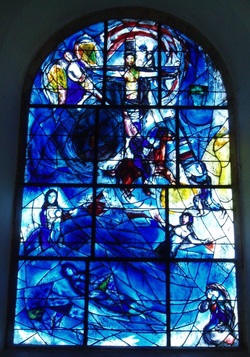 The East Window, Tudeley
The East Window, Tudeley Chagall's work included murals for Granovsky's Jewish Theatre in Moscow, and illustrations for La Fontaine's Fables, Gogol's Dead Souls, and the Bible.
I was delighted on a visit to Paris with a school group a couple of years back, to come across a ceiling painted by Chagall for the Paris Opéra, and I also paid an early morning visit to the cathedral in Metz, en route home from a Swiss mountain tour for a party of heart-bypass survivors from Folkestone(in case of any confusion, I was their courier!) to see a beautiful yellow-tinted stained-glass window. Sadly, my recent visit to Tossa de Mar on Catalunya's Costa Brava was just a couple of hours too whistle-stop fast to see his Celestial Violinist at the Municipal Museum.
I am lucky enough, however, to have easy access to an outstanding work of Chagall's just a few miles from home at All Saints Church, Tudeley. Uniquely in the world, all of the church's twelve windows are decorated by the artist. The east window is a memorial tribute to Sarah d'Avigdor-Goldsmid, who died in 1963 aged 21 in a sailing accident off the Cinque Port of Rye.
Sarah was the daughter of Sir Henry and Lady d'Avigdor-Goldsmid, who lived at that time in the nearby Jacobean house, Somerhill. Sarah herself had been interested in contemporary art, and in fact she had bought the first painting David Hockney ever sold, from his student show. On a visit to Paris in the early 1960s, Sarah had seen and loved the designs on exhibition for Chagall's windows for the Hadassah Medical Centre in Jerusalem. After her death, her parents commissioned Chagall to design the east window in her memory. Sarah's mother and sister Chloe were Anglican, while her father was Jewish.
Sarah was descended through her father from Sir Isaac Lyon Goldsmid, (1778 –1859) a financier who was one of the leading figures in the Jewish emancipation in Britain. There must surely then have been a social connection in the past with another local notable Jewish family, the Salomons of Southborough, who also lost a beloved child at sea on 28 October 1915 when David Salomons drowned in the Hythe tragedy.
Although Chagall took some persuasion by the D'Avigdor Goldsmids to take on the commission, when he arrived in 1967 for the installation of the east window, he was thrilled by the church, and is reported to have said, 'It's magnificent. I will do them all.' He took 15 years to design the remaining eleven windows. He collaborated in this case as in others with French glassworker Charles Marq of Reims. The final installation of the chancel windows took place in 1985, the year of Chagall's death at the age of 98.
The Tudeley windows were inspired, said Chagall, by the words of Psalm 8, and in particular verses 4-8:
"What is man that thou art mindful of him, and the son of man that thou visitest him? For thou hast made him a little lower than the angels and hast crowned him with glory and honour. Thou madest him to have dominion over the works of thy hands; thou hast put all things under his feet: all sheep and oxen, yea, and the beasts of the field, the fowl of the air, and the fish of the sea, and whatsoever passeth through the paths of the seas."
If you are within reach of Tudeley and have never seen the magnificent windows, they are well worth a visit, not only as great art, but also for the opportunity for a quiet contemplative moment in a beautiful countryside setting.
Some other opportunities to see a collection of Chagall's work this year include the exhibition Chagall - Between War and Peace at the Musee du Luxembourg in the Luxembourg Gardens on Paris's Left Bank, which ends 21 July, and Chagall - Modern Master at Tate Liverpool, which opens next week on 8 June until 6 October, and which brings together more than sixty paintings and a selection of works on paper from across the world.

 RSS Feed
RSS Feed
